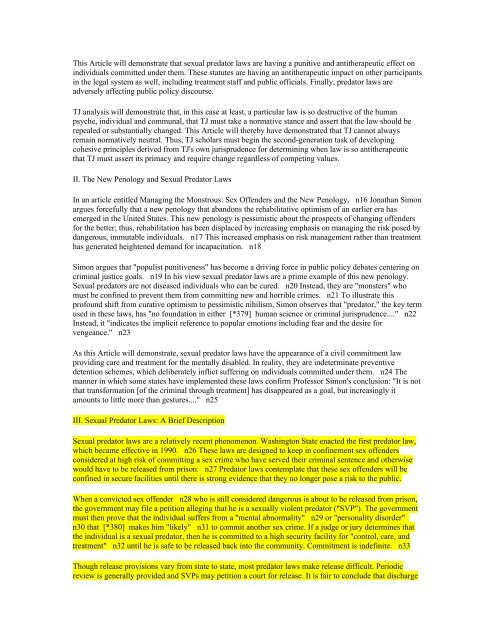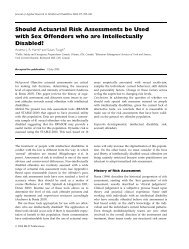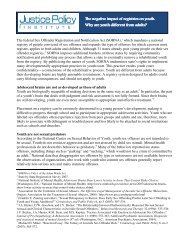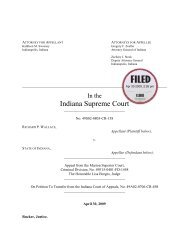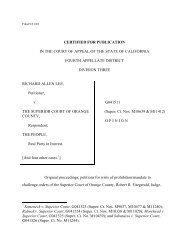Therapeutic Jurisp & Sexual Predator Laws - Defense for SVP
Therapeutic Jurisp & Sexual Predator Laws - Defense for SVP
Therapeutic Jurisp & Sexual Predator Laws - Defense for SVP
Create successful ePaper yourself
Turn your PDF publications into a flip-book with our unique Google optimized e-Paper software.
This Article will demonstrate that sexual predator laws are having a punitive and antitherapeutic effect onindividuals committed under them. These statutes are having an antitherapeutic impact on other participantsin the legal system as well, including treatment staff and public officials. Finally, predator laws areadversely affecting public policy discourse.TJ analysis will demonstrate that, in this case at least, a particular law is so destructive of the humanpsyche, individual and communal, that TJ must take a normative stance and assert that the law should berepealed or substantially changed. This Article will thereby have demonstrated that TJ cannot alwaysremain normatively neutral. Thus, TJ scholars must begin the second-generation task of developingcohesive principles derived from TJ's own jurisprudence <strong>for</strong> determining when law is so antitherapeuticthat TJ must assert its primacy and require change regardless of competing values.II. The New Penology and <strong>Sexual</strong> <strong>Predator</strong> <strong>Laws</strong>In an article entitled Managing the Monstrous: Sex Offenders and the New Penology, n16 Jonathan Simonargues <strong>for</strong>cefully that a new penology that abandons the rehabilitative optimism of an earlier era hasemerged in the United States. This new penology is pessimistic about the prospects of changing offenders<strong>for</strong> the better; thus, rehabilitation has been displaced by increasing emphasis on managing the risk posed bydangerous, immutable individuals. n17 This increased emphasis on risk management rather than treatmenthas generated heightened demand <strong>for</strong> incapacitation. n18Simon argues that "populist punitiveness" has become a driving <strong>for</strong>ce in public policy debates centering oncriminal justice goals. n19 In his view sexual predator laws are a prime example of this new penology.<strong>Sexual</strong> predators are not diseased individuals who can be cured. n20 Instead, they are "monsters" whomust be confined to prevent them from committing new and horrible crimes. n21 To illustrate thisprofound shift from curative optimism to pessimistic nihilism, Simon observes that "predator," the key termused in these laws, has "no foundation in either [*379] human science or criminal jurisprudence...." n22Instead, it "indicates the implicit reference to popular emotions including fear and the desire <strong>for</strong>vengeance." n23As this Article will demonstrate, sexual predator laws have the appearance of a civil commitment lawproviding care and treatment <strong>for</strong> the mentally disabled. In reality, they are indeterminate preventivedetention schemes, which deliberately inflict suffering on individuals committed under them. n24 Themanner in which some states have implemented these laws confirm Professor Simon's conclusion: "It is notthat trans<strong>for</strong>mation [of the criminal through treatment] has disappeared as a goal, but increasingly itamounts to little more than gestures...." n25III. <strong>Sexual</strong> <strong>Predator</strong> <strong>Laws</strong>: A Brief Description<strong>Sexual</strong> predator laws are a relatively recent phenomenon. Washington State enacted the first predator law,which became effective in 1990. n26 These laws are designed to keep in confinement sex offendersconsidered at high risk of committing a sex crime who have served their criminal sentence and otherwisewould have to be released from prison. n27 <strong>Predator</strong> laws contemplate that these sex offenders will beconfined in secure facilities until there is strong evidence that they no longer pose a risk to the public.When a convicted sex offender n28 who is still considered dangerous is about to be released from prison,the government may file a petition alleging that he is a sexually violent predator ("<strong>SVP</strong>"). The governmentmust then prove that the individual suffers from a "mental abnormality" n29 or "personality disorder"n30 that [*380] makes him "likely" n31 to commit another sex crime. If a judge or jury determines thatthe individual is a sexual predator, then he is committed to a high security facility <strong>for</strong> "control, care, andtreatment" n32 until he is safe to be released back into the community. Commitment is indefinite. n33Though release provisions vary from state to state, most predator laws make release difficult. Periodicreview is generally provided and <strong>SVP</strong>s may petition a court <strong>for</strong> release. It is fair to conclude that discharge


